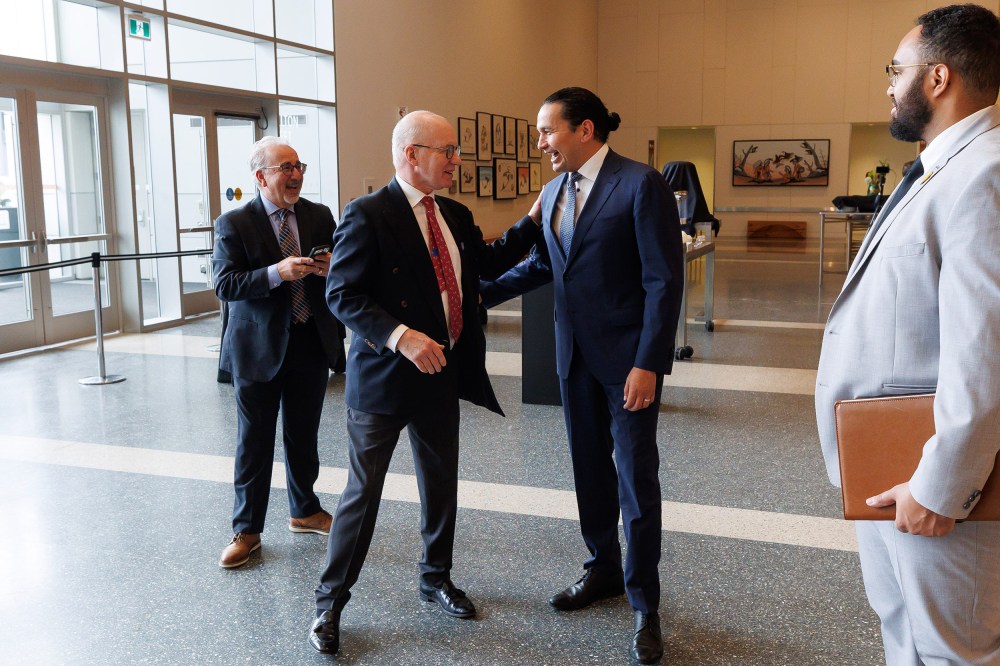Wab Kinew is not the first Manitoba premier to make the unrealistic claim that with the right economic plan, the province could shed its “have-not” status and stop collecting equalization payments from the federal government.
Many premiers have made similar pronouncements in the past. They usually do so early in their mandates, when they can make freewheeling, crystal-ball predictions without having to be accountable for them.
Kinew, who’s been premier for seven months, repeated the fallacious claim Tuesday during a Manitoba Chamber of Commerce breakfast speech at the RBC Convention Centre. He said Manitoba could wean itself off federal equalization payments, which account for nearly one-fifth of the province’s $23.3-billion budget, if it could get more people working.

Premier Wab Kinew chats with attendees before giving a state of the province address at a Manitoba Chambers of Commerce breakfast Tuesday morning.
That is, at best, a pipe dream. At worst, it’s a deliberate attempt to mislead.
In federal-provincial relations parlance, “have” provinces — such as Alberta, Saskatchewan, and British Columbia — do not receive equalization payments (which are designed to ensure all provinces can provide similar levels of service at similar levels of taxation).
The rest, including Manitoba, are considered “have-not” provinces, although some are more have-not than others. Ontario has received equalization in six of the past 10 years, but its payments have been relatively tiny. Manitoba’s equalization payments per capita are among the highest in the country.
Kinew told the business crowd that if Manitoba could improve its participation rate in the labour market (the percentage of those aged 15 and over who either have a job or are actively looking for one), it could boost the province’s per capita GDP high enough to end equalization payments.
That is pure fantasy.
“It’s not that we have an unemployment-rate problem, we have a participation-rate problem,” said Kinew. “When those folks start to earn a paycheque… that’s how we turn Manitoba from being a ‘have-not’ province into a ‘have’ province.”
Not exactly.
For starters, Manitoba doesn’t have a participation-rate problem, at least not compared with other provinces. At 66.3 per cent, Manitoba’s participation rate in April was slightly above the national average of 65.4 per cent. It was higher than six other provinces, including British Columbia (65.2 per cent), which is a “have” province.
Alberta’s was the highest at 70.1 per cent.
The notion that all Manitoba has to do to become a “have” province is to get more people into the workforce is not only far-fetched, it’s inaccurate.
Equalization is based on a complicated formula that measures a province’s relative fiscal capacity. The federal government gauges a province’s ability to raise its own taxation and other revenue and compares it to a 10-province average.
Manitoba’s fiscal capacity is by far one of the lowest in the country, higher only than New Brunswick, Nova Scotia and Prince Edward Island. As a result, it receives the highest per capita equalization payments west of the Maritimes (far higher than Quebec’s).
It would take billions of dollars in additional economic output to bring Manitoba’s fiscal capacity up to the national standard, where it would no longer require equalization payments. No credible economic forecast is showing that.
Adding a few percentage points to Manitoba’s labour force participation rate wouldn’t do it.
When Kinew was asked following his speech how high the participation rate would have to climb for Manitoba to eliminate its ‘have-not’ status, the premier wouldn’t give a number. He would say only that he would like to see it rise.
When pressed further by reporters about his desire to see Manitoba wean itself off equalization payments, he was more guarded.
“It’s very ambitious — that point I will concede,” Kinew said. “But I won’t ever question the need to have an ambitious vision for the future of our province.”
Fair enough.
At the same time, there was nothing in the premier’s speech that offered any hope of Manitoba breaking new economic ground.
Kinew laid out a three-point “cohesive economic strategy” he said would improve Manitoba’s economic standing.
The first point, to keep doing what it’s already doing in diversified sectors of the economy, such as agriculture and manufacturing, is to do nothing at all.
The second prong of the plan is to “cash in” on the province’s low-carbon economy and its cheap hydro-electricity, which it’s been doing for decades. Nothing new there.
The third point is to boost employment through better education, a vague notion Manitoba premiers have talked about since time immemorial.
“We have to improve inter-provincial migration rates,” Kinew told the breakfast crowd, pointing out that Manitoba is losing more people to other provinces than it has been in the past.
That is true. Manitoba lost a net 8,979 people to other provinces in 2023, the highest number in at least 20 years.
Trouble is, Kinew failed to lay out a realistic plan to stem that tide or to significantly improve Manitoba’s economic fortunes beyond the steps the business community and the provincial government have been taking for years.
Kinew may have been brimming with optimism Tuesday, as premiers usually are early in their mandates. But his speech was more sizzle than steak.
tom.brodbeck@freepress.mb.ca

Tom Brodbeck
Columnist
Tom has been covering Manitoba politics since the early 1990s and joined the Winnipeg Free Press news team in 2019.
Our newsroom depends on a growing audience of readers to power our journalism. If you are not a paid reader, please consider becoming a subscriber.
Our newsroom depends on its audience of readers to power our journalism. Thank you for your support.